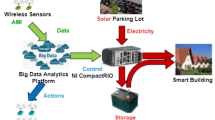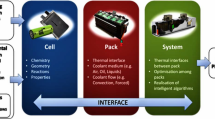Abstract
The proliferation of data centers is driving increased energy consumption, leading to environmentally unacceptable carbon emissions. As the use of Internet-of-Things (IoT) techniques for extensive data collection in data centers continues to grow, deep learning-based solutions have emerged as attractive alternatives to suboptimal traditional methods. However, existing approaches suffer from unsatisfactory performance, unrealistic assumptions, and an inability to address practical data center optimization. In this paper, we focus on power usage effectiveness (PUE) optimization in IoT-enabled data centers using deep learning algorithms. We first develop a deep learning-based PUE optimization framework tailored to IoT-enabled data centers. We then formulate the general PUE optimization problem, simplifying and specifying it for the minimization of long-term energy consumption in chiller cooling systems. Additionally, we introduce a transformer-based prediction network designed for energy consumption forecasting. Subsequently, we transform this formulation into a Markov decision process (MDP) and present the branching double dueling deep Q-network. This approach effectively tackles the challenges posed by enormous action spaces within MDP by branching actions into sub-actions. Extensive experiments conducted on real-world datasets demonstrate the exceptional performance of our algorithms, excelling in prediction precision, optimization convergence, and optimality while effectively managing a substantial number of actions on the order of \(10^{13}\).









Similar content being viewed by others
Availability of data and materials
Not applicable.
Code availability
Not applicable.
Notes
In this subsection, for simplicity, we represent \(\textbf{X}_{1:t}\) as \(\textbf{X}\).
The Q-networks within them would necessitate vast computational resources, roughly around 60 TB in practice, posing a considerable challenge to attain.
In this paper, we optimize two chillers, each with the same set of five parameters. To maintain conciseness, we select only five parameters from chiller 1 and one parameter from chiller 2 for comparison.
References
Andrae ASG, Edler T (2015) On global electricity usage of communication technology: trends to 2030. Challenges 6(1):117–157. https://doi.org/10.3390/challe6010117
Cao Z, Zhou X, Hu H, Wang Z, Wen Y (2022) Toward a systematic survey for carbon neutral data centers. IEEE Communications Surveys & Tutorials 24(2):895–936. https://doi.org/10.1109/COMST.2022.3161275
Peter J (2021) Chinese government calls for 200 exaflops of data center compute by 2023. https://www.datacenterdynamics.com/en/news/chinese-government-calls-for-200-exaflops-of-data-center-compute-by-2023/
Ni J, Bai X (2017) A review of air conditioning energy performance in data centers. Renew Sustain Energy Rev 67:625–640. https://doi.org/10.1016/j.rser.2016.09.050
Jackson Ramphela MK, Owolawi PA, Mapayi T, Aiyetoro G (2020) Internet of Things (IoT) integrated data center infrastructure monitoring system. In: 2020 international conference on artificial intelligence, big data, computing and data communication systems (icABCD), pp 1–6. https://doi.org/10.1109/icABCD49160.2020.9183873
Medina-Santiago A, Azucena ADP, Gómez-Zea JM, Jesús-Magaña JA, de la Luz Valdez-Ramos M, Sosa-Silva E, Falcón-Pérez F (2020) Adaptive model IoT for monitoring in data centers. IEEE Access 8:5622–5634. https://doi.org/10.1109/ACCESS.2019.2963061
Xue J, Xu Y, Wu W, Zhang T, Shen Q, Zhou H, Zhuang W (2024) Sparse Mobile Crowdsensing for Cost-Effective Traffic State Estimation With Spatio-Temporal Transformer Graph Neural Network. IEEE Internet Things J 1–1. https://doi.org/10.1109/JIOT.2024.3356554
Wu H, Zhou H, Zhao J, Xu Y, Qian B, Shen X (2022) Deep learning enabled fine-grained path planning for connected vehicular networks. IEEE Transactions on Vehicular Technology 71(10):10303–10315. https://doi.org/10.1109/TVT.2022.3185249
Xiao P, Qin Z, Chen D, Zhang N, Ding Y, Deng F, Qin Z, Pang M (2023) FastNet: a lightweight convolutional neural network for tumors fast identification in mobile-computer-assisted devices. IEEE Internet Things J 10(11):9878–9891. https://doi.org/10.1109/JIOT.2023.3235651
Xue J, Yu K, Zhang T, Zhou H, Zhao L, Shen X (2024) Cooperative deep reinforcement learning enabled power allocation for packet duplication URLLC in multi-connectivity vehicular networks. IEEE Transactions on Mobile Computing 1–15. https://doi.org/10.1109/TMC.2023.3347580
Vu HD, Chai KS, Keating B, Tursynbek N, Xu B, Yang K, Yang X, Zhang Z (2017) Data driven chiller plant energy optimization with domain knowledge. In: Proceedings of the 2017 ACM on conference on information and knowledge management. CIKM ’17, pp 1309–1317. Association for Computing Machinery, New York, NY, USA. https://doi.org/10.1145/3132847.3132860
Yang Z, Du J, Lin Y, Du Z, Xia L, Zhao Q, Guan X (2022) Increasing the energy efficiency of a data center based on machine learning. Journal of Industrial Ecology 26(1):323–335. https://doi.org/10.1111/jiec.13155
Zhao P, Yang L, Kang Z, Lin J (2019) On predicting the PUE with gated recurrent unit in data centers. In: 2019 IEEE 5th international conference on computer and communications (ICCC), pp 1664–1670. https://doi.org/10.1109/ICCC47050.2019.9064040
Heimerson A, Sjölund J, Brännvall R, Gustafsson J, Eker J (2022) Adaptive control of data center cooling using deep reinforcement learning. In: 2022 IEEE international conference on autonomic computing and self-organizing systems companion (ACSOS-C), pp 1–6. https://doi.org/10.1109/ACSOSC56246.2022.00018
Li Y, Wen Y, Tao D, Guan K (2020) Transforming cooling optimization for green data center via deep reinforcement learning. IEEE Trans Cybern 50(5):2002–2013. https://doi.org/10.1109/TCYB.2019.2927410
Naug A, Quinones-Grueiro M, Biswas G (2022) Reinforcement learning-based HVAC supervisory control of a multi-zone building- A real case study. In: 2022 IEEE conference on control technology and applications (CCTA), pp 1172–1177. https://doi.org/10.1109/CCTA49430.2022.9966081
Ma Z, Wang S (2009) An optimal control strategy for complex building central chilled water systems for practical and real-time applications. Build Environ 44(6):1188–1198. https://doi.org/10.1016/j.buildenv.2008.08.011
Sun J, Reddy A (2005) Optimal control of building HVAC &R systems using complete simulation-based sequential quadratic programming (CSB-SQP). Building and Environment 40(5):657–669. https://doi.org/10.1016/j.buildenv.2004.08.011
Lu L, Cai W, Xie L, Li S, Soh YC (2005) HVAC system optimization—in-building section. Energy and Buildings 37(1):11–22. https://doi.org/10.1016/j.enbuild.2003.12.007
Fang Q, Wang J, Gong Q, Song M (2017) Thermal-aware energy management of an HPC data center via two-time-scale control. IEEE Transactions on Industrial Informatics 13(5):2260–2269. https://doi.org/10.1109/TII.2017.2698603
Balaras CA, Lelekis J, Dascalaki EG, Atsidaftis D (2017) High performance data centers and energy efficiency potential in Greece. Procedia Environ Sci 38:107–114. https://doi.org/10.1016/j.proenv.2017.03.091
Mnih V, Kavukcuoglu K, Silver D, Rusu AA, Veness J, Bellemare MG, Graves A, Riedmiller M, Fidjeland AK, Ostrovski G, Petersen S, Beattie C, Sadik A, Antonoglou I, King H, Kumaran D, Wierstra D, Legg S, Hassabis D (2015) Human-level control through deep reinforcement learning. Nature 518(7540):529–533. https://doi.org/10.1038/nature14236
Wang Z, Schaul T, Hessel M, Hasselt H, Lanctot M, Freitas N (2016) Dueling network architectures for deep reinforcement learning. In: Proceedings of the 33rd international conference on machine learning, pp 1995–2003. PMLR
Hasselt H, Guez A, Silver D (2016) Deep reinforcement learning with double Q-Learning. Proceedings of the AAAI Conference on Artificial Intelligence 30(1). https://doi.org/10.1609/aaai.v30i1.10295
Yu K, Zhou H, Tang Z, Shen X, Hou F (2021) Deep reinforcement learning-based RAN slicing for UL/DL decoupled cellular V2X. IEEE Trans Wirel Commun 1–1. https://doi.org/10.1109/TWC.2021.3122941
Liu Z, Yu K, Zhang T, Liu J, Chen J, Zhou H, Shen XS (2023) Leveraging deep reinforcement learning for geolocation-based MIMO transmission in FD-RAN. In: 2023 IEEE/CIC International conference on communications in China (ICCC), pp 1–6. https://doi.org/10.1109/ICCC57788.2023.10233428
Ding Y, Qin X, Zhang M, Geng J, Chen D, Deng F, Song C (2023) RLSegNet: an medical image segmentation network based on reinforcement learning. IEEE/ACM Transactions on Computational Biology and Bioinformatics 20(4):2565–2576. https://doi.org/10.1109/TCBB.2022.3195705
Dayarathna M, Wen Y, Fan R (2016) Data center energy consumption modeling: a survey. IEEE Communications Surveys & Tutorials 18(1):732–794. https://doi.org/10.1109/COMST.2015.2481183
Vaswani A, Shazeer N, Parmar N, Uszkoreit J, Jones L, Gomez AN, Kaiser Ł, Polosukhin I (2017) Attention is all you need. In: Advances in neural information processing systems, vol 30. Curran Associates, Inc
Bahdanau D, Cho K, Bengio Y (2016) Neural machine translation by jointly learning to align and translate. https://doi.org/10.48550/arXiv.1409.0473
Chaudhari S, Mithal V, Polatkan G, Ramanath R (2021) An attentive survey of attention models. ACM Trans Intell Syst Technol 12(5):53–15332. https://doi.org/10.1145/3465055
He K, Zhang X, Ren S, Sun J (2016) Deep residual learning for image recognition. In: 2016 IEEE conference on computer vision and pattern recognition (CVPR), pp 770–778. https://doi.org/10.1109/CVPR.2016.90
Ba JL, Kiros JR, Hinton GE (2016) Layer normalization. https://doi.org/10.48550/arXiv.1607.06450
Tavakoli A, Pardo F, Kormushev P (2018) Action branching architectures for deep reinforcement learning. Proc AAAI Conf Artif Intell 32(1). https://doi.org/10.1609/aaai.v32i1.11798
Schaul T, Quan J, Antonoglou I, Silver D (2016) Prioritized experience replay. https://doi.org/10.48550/arXiv.1511.05952
Funding
No funding was received for this study.
Author information
Authors and Affiliations
Contributions
Conceptualization, Y.S. and H.Z.; methodology, Y.S., G.J. and Y.W.; simulation, G.J. and Y.W.; formal analysis, Y.S.; investigation, H.Z.; resources, B.C. and H.Z.; data curation, G.J.; writing-original draft preparation, Y.S.; writing-review and editing, B.C., H.Z.; visualization, Y.S.; supervision, H.Z.; project administration, B.C. and H.Z.
Corresponding author
Ethics declarations
Competing interests
The authors declare no competing interests.
Ethics approval
Not applicable.
Consent to participate
Not applicable.
Consent for publication
I hereby declare, on behalf of my co-authors, that the work described constitutes original research which has not been previously published, in whole or in part, and is not currently under consideration for publication elsewhere. Furthermore, we affirm that informed consent from study participants has been duly obtained for the publication of the information/images in an online open-access publication.
Additional information
Publisher's Note
Springer Nature remains neutral with regard to jurisdictional claims in published maps and institutional affiliations.
This article is part of the Topical Collection: Special Issue on Affordable and Clean Energy
Guest Editors: Dajiang Chen, Ning Zhang, and Chunpeng Ge
Rights and permissions
Springer Nature or its licensor (e.g. a society or other partner) holds exclusive rights to this article under a publishing agreement with the author(s) or other rightsholder(s); author self-archiving of the accepted manuscript version of this article is solely governed by the terms of such publishing agreement and applicable law.
About this article
Cite this article
Sun, Y., Wang, Y., Jiang, G. et al. Deep learning-based power usage effectiveness optimization for IoT-enabled data center. Peer-to-Peer Netw. Appl. (2024). https://doi.org/10.1007/s12083-024-01663-5
Received:
Accepted:
Published:
DOI: https://doi.org/10.1007/s12083-024-01663-5




